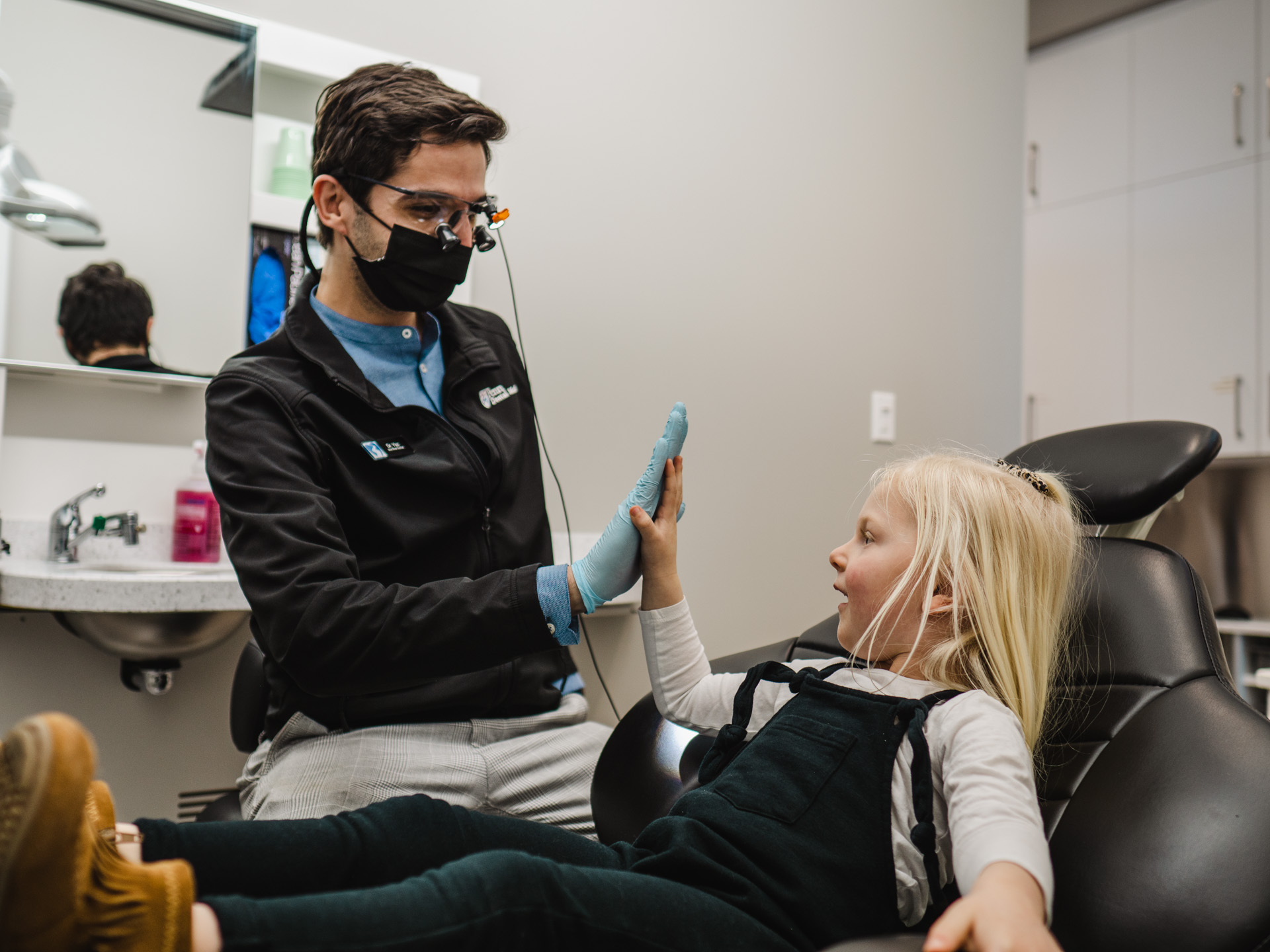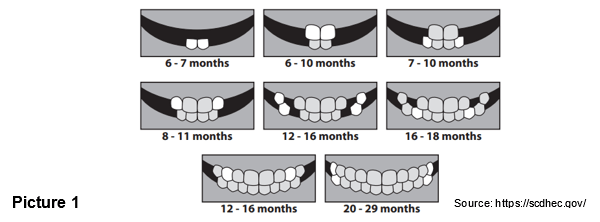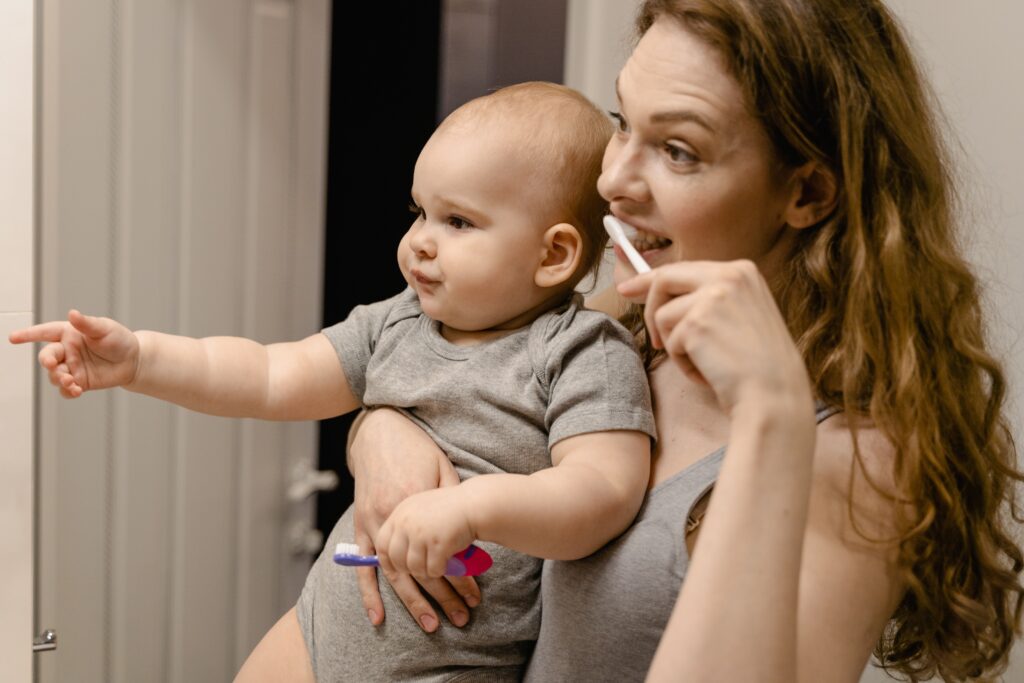Pediatric Dentistry in Cochrane, Alberta
Here at Bow River Dental Centre, Family Dentistry is our passion and we cater to patients of all ages. We consider it a privilege to guide the parents of Cochrane, Alberta through their child’s dental health journey, beginning with the first visit.
Homecare is an important place to start, as your child’s first dental visit won’t happen until age 3. This page will guide you through the essentials of teeth and gum care for infants and toddlers.

Dental Homecare for Toddlers and Infants
Although baby teeth will eventually be replaced by adult (permanent) teeth, they still need to be cared for. Infant teeth and gum care ought to begin as soon as possible, even before the first tooth emerges.
The Importance of Healthy Baby Teeth and Gums
Already embedded in your child’s jaw before birth, baby teeth signal the beginning of an individual’s dental health journey.
Baby teeth serve several crucial functions. Your child’s face shape is informed by their growth as they hold space for adult teeth to grow properly. Chewing, eating, and talking, are all facilitated by baby teeth.
Baby Teeth Growth Timeline
Your child’s first tooth will appear within the first 6 months. Within 20-29 months, all 20 baby teeth should have pushed through the gums.
Starting around age 6 to 7, your child’s front teeth will fall out and the tooth fairy journey begins! The back teeth will be the last to fall out as they are important for chewing and digestion. You can expect those last baby teeth to fall out between the ages of 10 to 12.

Source: Nationwide Children’s

Tooth Decay, Cavities, and Baby Teeth
Preventative dental home care should begin as early as possible to prevent cavities and tooth decay. Even though your child’s baby teeth will fall out, it is still crucial to keep them healthy.
Treating cavities in baby teeth can still necessitate costly dental or emergency dental procedures. They need to be avoided because they can cause pain, leading to missed daycare or school days. Additionally, tooth decay can harm the permanent teeth that are developing below the gumline.
Infant Feeding Caries
Did you know that the front four baby teeth are the most susceptible to tooth decay? Referred to as infant feeding caries, this condition is related to feeding.
As tempting as it can be to allow your baby to fall asleep right after a feeding, it can lead to cavities. Breast milk and formula both contain lactose and/or other sugars that are necessary for your baby’s healthy development, but can cause tooth decay in their baby teeth.
When falling asleep immediately after feeding, some leftover milk can pool in the front of your child’s mouth. All sugars create an acidic environment, allowing plaque to form on the teeth. This plaque leads to tooth decay and eventually, the cavity process, known as caries, begins. At first, caries will appear as a chalky white area which can eventually turn black or brown.
Baby Feeding Tips For Optimal Dental Health
Starting your baby’s feeding journey with these tips in mind will go a long way in optimizing their dental health.
Before your baby’s teeth appear:
- If your baby falls asleep during breastfeeding, remove the breast from their mouth.
- Avoid using breastfeeding or a bottle as a pacifier: save them for feeding-time only.
- Do not use feeding as a way to put your baby to sleep.
After the first tooth appears:
- Avoid frequent, on-demand, and night feedings.
- Wean your baby from bottle to cup by the time they turn 1.
- After age 1, your child can begin sipping water at any time during the day when thirsty.
- Avoid giving your child anything other than water to drink, except at mealtime.
Teething Symptoms and How to Help
Teething is a natural process that does unfortunately cause your child some pain, but not enough to cause crying or fever. If your child is crying or experiencing a fever while teething, seek another cause. Common signs of teething pain are fussiness, more drooling than usual, and gum rubbing.
The best way to address this pain is similar to brushing your baby’s teeth and gums (below). You can gently massage their gums with a clean finger. Alternatively, there are teething toys that should be kept clean and cold for your baby’s comfort. The toys give your child the ability to self-soothe, although they may instinctively use their fingers to rub their gums themselves.
Pacifiers and Thumb-sucking
From a dental health perspective, thumb-sucking and pacifier use don’t negatively impact baby teeth. Certainly, sucking is a natural, healthy behaviour that facilitates your child’s ability to eat and drink. However, these practices can cause issues for the development of permanent teeth, particularly between the ages of 2 – 4.
Opinions are divided when it comes to weaning suggestions and whether thumb sucking is better than pacifier use or visa versa. Either way, weaning your child off this practice by age 2 will help their permanent teeth grow properly.
Brushing and Cleaning for Babies and Children
Caring for your child’s teeth and gums will change as their mouth goes through changes. Overall, ensure that you are cleaning your child’s mouth at least twice a day, especially after feedings.
Read on to learn how to care for your child’s teeth before and after the teeth come in:
Fluoride-containing Toothpaste in Small Doses
Fluoride is proven to protect teeth by making them stronger and shielding them from tooth decay.
After your child’s first dental visit, we might apply a coating of fluoride on their teeth to bolster their dental health. It is also recommended that you use fluoride-containing toothpaste in small amounts.

How To Clean Newborn Baby Teeth and Gums
Before your baby’s teeth come in, you will use gauze or cloth to clean their mouth.
Choose a soft cloth wrapped over your finger or a clean gauze pad. Ensure that the material is damp, but not wet enough to drip.
You only need to use a rice grain-sized amount of toothpaste before your child turns 3.
Hold or place your child in the most comfortable position for you both.
Gently use the damp material and toothpaste to wipe your child’s gums.
Cleaning and Brushing After Age 3
Your child can also start learning how to brush their teeth starting at age 2. A great way to begin this education is to simply allow them to watch you brush your teeth. The goal is to have them brush their teeth alone by age 10.
Once your child has turned 3 and you can easily see the inside of their mouth, you can begin using a pea-sized squeeze of toothpaste. At this stage, use a small, soft-bristled toothbrush, damp but not wet.
You will use gentle, angled, and circular motions along a row of teeth, against the gum line. Avoid brushing back and forth, as this motion is too abrasive for the still-developing teeth and gums. Pay attention to the entire surface area of your child’s gums and teeth, finishing up by brushing the tongue.
At this stage of dental care, get your child accustomed to spitting out the toothpaste. If they can’t, the small amounts of toothpaste won’t cause any harm when swallowed.

Diet and Feeding Guidelines for Your Child
Establishing great dental care habits goes hand-in-hand with a healthy diet, for children and adults alike. Outside of regular meals and snacks, ensure that your child isn’t doing additional snacking and drinking throughout the day. The accumulating sugar in their mouth can contribute to tooth decay and cavities.
Drink Tips for Young Children:
- Children less than a year old should not have any sugary drinks, juice, or water. During this time, stick with breastmilk or formula.
- After their first birthday, offer water in between meals when your child is thirsty.
- Save other beverages for mealtimes. Half a cup (4 ounces) of 100% pure juice is recommended.
- Do not add any sugars, sweeteners, or honey to drinks.
Food Tips for Young Children:
- Steer clear of gummy or starchy snacks like dried fruit or potato chips, as these stick to teeth and are difficult to clean out thoroughly.
- Choose raw, crunchy fruit and vegetables as snacks, as they are hydrating and help keep teeth and gums healthy.
